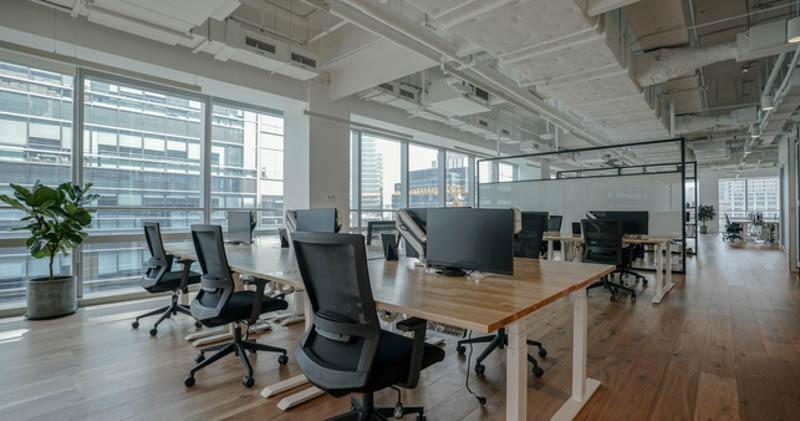
Today’s modern workplace continues to evolve to meet the needs of both employers and employees. New technologies supporting digital workplaces;, employees now preferring to work remotely; conformity to culture change shifting; and fresh security concerns are some of the things defining the modern workplace.
“Modern workplace” is a term used to describe businesses who recognise digital collaboration, technology and tools as the way of the future. For example, workplaces that embrace digital technology and tools and 21st-century interior design, with the aim of improving employee productivity and satisfaction.
Understanding Modern Workplace
To understand how the modern workplace is today and how it is likely to look like in the future, you need to know the types of spaces and devices or items that dominate it. Just swing by any modern and innovative company, and you will likely find some of these:
Private Spaces
As the name suggests, these are spaces workers occupy when they need to de-stress, and need some quiet and a moment away from the day-to-day hustle and bustle. Employees who work better when secluded will also find these places very accommodating. Phone booths and private rooms are an excellent example of private places.
Hot Desks
Also known as hotel desks, they allow you to maximise office space and increase accommodation in your office. For in-office workers, these desks give them the freedom to choose where to sit and work every day. Remote workers will also benefit from hot desks when physically present in the office.
Agile Workplaces
These places are designed to adapt to accommodate different groups and purposes in the blink of an eye. They are commonly used to hold performance evaluations, pitch a presentation, promote team collaboration, and more. They are normally fitted with appropriate technology such as TVs and printers, are booked in advanced, and managed accordingly. It is common to see these spaces shared by different departments.
Collaboration Environments
Collaborative environments exist for various purposes, including group projects, brainstorming sessions, and presentations. They can either be dedicated or agile spaces based on a company’s needs. Some are as simple as a conference room, while others can be uniquely designed areas.
Examples of collaborative technologies include Microsoft Office and Teams, as well as Google Workplace.*
Amenities
Employees are more concerned about their work-life balance than ever before. This has resulted in the redesign of office spaces purposively to attract and retain talent. It is common today to find nap rooms, gyms, game rooms, and cafeterias in many modern workplaces.
Desk Neighbourhood
Neighbourhood seating supports an agile work environment and brings about a substantial advantage to the workplace. By grouping employees together, you foster better communication and collaboration, resulting in a better employee experience.
The evolution of desk neighbourhood has help phase out cubicle grouping and nurture a better company culture through a broader social work experience.
Uniqueness
The uniqueness of the spaces in modern workplaces is what sets them apart. They are unique in their own way. From furniture to the types of electronics fitted, a business can make a major impact on a workplace’s look and cultural vibe. For example, some businesses furnish their workplaces with designer furniture, while others opt for minimalist design with concrete floors and blocky furniture.
Making the Transition
Modernising your workplace doesn’t need to be a stressful task if you understand your employees’ needs and what your budget can allow you to do. For example, if employees prefer to work in a space with cool amenities, see what you can manage to offer without breaking the bank. You don’t necessarily have to offer an all-rounded package.
Want More Productivity Tips?
Employsure can help your business better understand workplace relations, including how to get the best out of your employees. Call us now for free, initial advice.

Need Workplace Advice?
Want to know more about workplace relations? Call us now for free, initial advice.
Frequently Asked Questions
What is a Modern Work Environment?
A modern work environment is considered to be an adaptable workplace that incorporates the best of digital technology, especially collaborative technology, as well as modern interior design into the workspace and work methods .
How Does the Modern Workplace Benefit us?
The modern workplace can benefit employers in numerous ways. According to a survey by BetterCloud, it can encourage a more collaborative culture, unite the workforce, provide more time for new ideas, and most importantly in the age of COVID, allow employees to more readily work from home.
What are Workplace Trends?
Workplace trends refer to the latest popular developments in managing the workplace including workplace technology and interior design.
Why is it Important to Understand Workplace Trends?
It is important to understand workplace trends as they may give you insight into the desires of the workforce, and how to improve your employees’ productivity by getting the best out of the latest software and technology.
What are Examples of Trends in the Workforce?
Examples of trends in the workforce include remote working, workplace flexibility, work-life balance and employee wellness, according to SpaceIQ.
Why Should you Engage in Modern Workplace Efforts?
You should engage in modern workplace efforts for a few reasons. First of all, modernizing your workplace may be a more efficient way of organizing your workplace. Secondly, it may better meet the needs of your employees, improving their happiness at work. Thirdly, it can help your business ensure it is adopting best practice workplace culture.
How has new Technology Affected the Modern Workplace?
The newest technology has affected the modern workplace in many obvious ways, e.g. tap-and-go payments. The biggest change new technology has made is that due to COVID many improvements have been made to assist employees work remotely from the office.
What is the Most Common Workplace Technology?
The most common workplace technology is perhaps the chair, or desk. But in terms of digital technology, computers and software are perhaps the most common workplace technologies in the Western world. Programs like Microsoft Office, Xero, SAP and Salesforce are some of the more common software programs that are used to facilitate business practices (note that Employsure is not necessarily recommending these programs)*.
BrightHR helping you manage your people and business
Contact us to find out how BrightHR people management software can help you manage and store your essential employee records and documents.
This blog has been compiled on the basis of general information current at the time of publication. Changes in circumstances after publication may affect the completeness or accuracy of this information. To the maximum extent permitted by law, we disclaim all liability for any errors or omissions contained in this information or any failure to update or correct this information. It is your responsibility to assess and verify the accuracy, completeness, currency and reliability of the information on this website, and to seek professional advice where necessary. Nothing contained on this website is to be interpreted as a recommendation to use any product, process or formulation or any information on this website. For clarity, Employsure does not recommend any material, products or services of any third parties.
